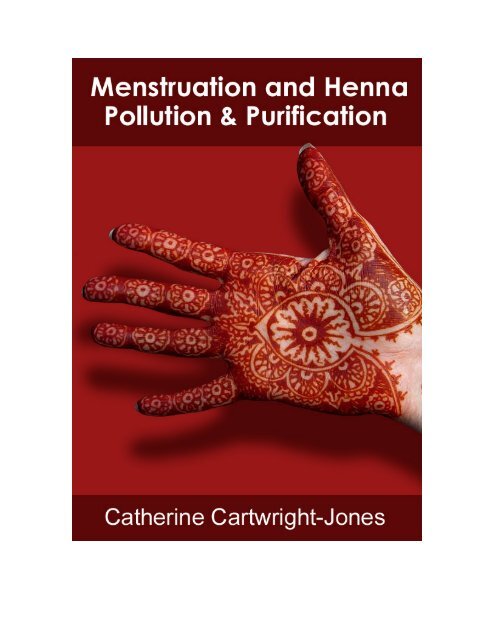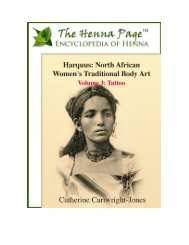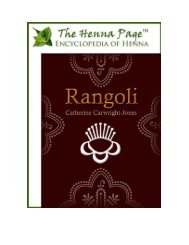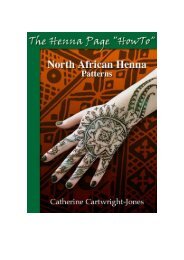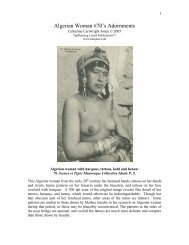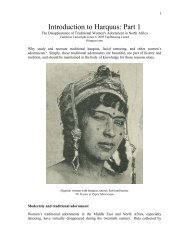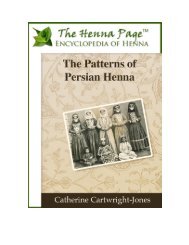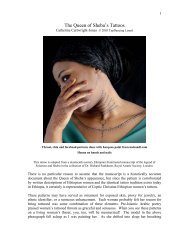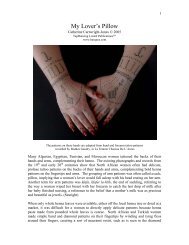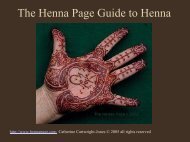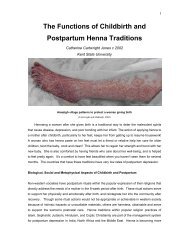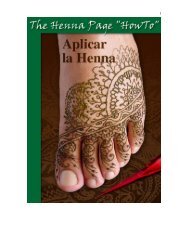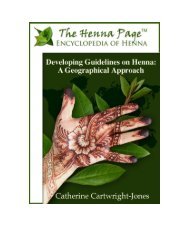Menstruation and Henna: Pollution and Purification - The Henna Page
Menstruation and Henna: Pollution and Purification - The Henna Page
Menstruation and Henna: Pollution and Purification - The Henna Page
Create successful ePaper yourself
Turn your PDF publications into a flip-book with our unique Google optimized e-Paper software.
<strong>Menstruation</strong> <strong>and</strong> <strong>Henna</strong>: <strong>Pollution</strong> <strong>and</strong> <strong>Purification</strong><br />
<strong>Henna</strong>’s role in Muslim Traditions Regarding Reproductive Blood<br />
Catherine Cartwright Jones, Kent State University<br />
Figure 1: <strong>Henna</strong>ed h<strong>and</strong>, by author<br />
In traditional Islam, a menstruating woman was considered vulnerable, weakened, <strong>and</strong> polluted;<br />
therefore she could not pray, fast, or have intercourse. Menstrual blood was najis, polluted,<br />
haram, very dirty, as were all blood, excrement <strong>and</strong> reproductive fluids. Islamic tradition<br />
emphasizes that Allah values people who are clean <strong>and</strong> pure, whereas malevolent jinn, predatory<br />
evil spirits, are not repulsed by filth, blood <strong>and</strong> decay, <strong>and</strong> may even find it attractive. In some<br />
Islamic traditions the jinn are believed strongly attracted to menstrual blood. For these believers,<br />
anyone who sees or touches menstrual blood is ritually impure <strong>and</strong> vulnerable to malevolent<br />
spirits, <strong>and</strong> dire consequences can follow. Running water <strong>and</strong> a thorough scrub purified a<br />
woman at the end of her menstrual cycle or other reproductive blood flow, so she could resume<br />
“<strong>Menstruation</strong> <strong>and</strong> <strong>Henna</strong>, <strong>Pollution</strong> <strong>and</strong> <strong>Purification</strong>”, was written by Catherine Cartwright-Jones as partial completion<br />
of the requirements for a Master’s degree in Liberal Studies focusing on henna, under the supervision of Dr. A Smith<br />
<strong>and</strong> Dr. N Ammar, Kent State University, Kent Ohio, USA<br />
2
prayer, fasting <strong>and</strong> intercourse, <strong>and</strong> dispel malevolent jinn. When she bathed, she also applied<br />
henna to her h<strong>and</strong>s, feet <strong>and</strong> hair. <strong>Henna</strong> stained her skin <strong>and</strong> hair dark blood-red, <strong>and</strong> remained<br />
visible for several weeks, showing that she had a purified body, worthy in the eyes of God <strong>and</strong><br />
her husb<strong>and</strong>, <strong>and</strong> repellant to malicious jinn.<br />
Figure 2: <strong>Henna</strong>ed h<strong>and</strong>s, patterns adapted from Ethiopian folk art: by author<br />
Islamic sacred texts, the Quran <strong>and</strong> Hadith, set the beliefs about jinn, menstruation <strong>and</strong> henna, but<br />
the interpretation <strong>and</strong> practice of these beliefs is always filtered through local tradition. Women<br />
throughout the Muslim world used henna, <strong>and</strong> cleansed after menstruation, because the Prophet<br />
“<strong>Menstruation</strong> <strong>and</strong> <strong>Henna</strong>, <strong>Pollution</strong> <strong>and</strong> <strong>Purification</strong>”, was written by Catherine Cartwright-Jones as partial completion<br />
of the requirements for a Master’s degree in Liberal Studies focusing on henna, under the supervision of Dr. A Smith<br />
<strong>and</strong> Dr. N Ammar, Kent State University, Kent Ohio, USA<br />
3
Mohammed recommended it. Different sects <strong>and</strong> tribes had different henna <strong>and</strong> cleansing<br />
techniques, visual symbols, exorcisms, <strong>and</strong> rituals reflecting local culture. <strong>Henna</strong> was frequently<br />
part of postmenstrual ghusl, the purification bath, applied in patterns <strong>and</strong> techniques varying<br />
according to local taste.<br />
Islam did not create these concepts about reproductive blood <strong>and</strong> henna; Islam adapted pre-<br />
existing Semitic traditions. Islamic menstrual taboos were based on a concept of pollution <strong>and</strong><br />
vulnerability versus purity <strong>and</strong> strength. Menstruating women were vulnerable to jinn <strong>and</strong> the<br />
Evil Eye, irresistibly drawn to blood, particularly reproductive blood. <strong>The</strong>se evil forces caused<br />
fitna, or disorder, which manifested as disease, inappropriate conduct, <strong>and</strong> tragedy. <strong>Henna</strong><br />
contained baraka, or blessedness, which protected the wearer from misfortune. Women used<br />
henna <strong>and</strong> protective patterns drawn with henna to purify their bodies, to preserve the health of<br />
their skin <strong>and</strong> hair, <strong>and</strong> to protect their souls <strong>and</strong> minds from attack by malevolent spirits.<br />
Women negotiated their menstrual <strong>and</strong> reproductive vulnerability through henna, wearing visible<br />
symbols to show that they were pure, strong, in good spiritual st<strong>and</strong>ing, as well as in emotional<br />
<strong>and</strong> physical health.<br />
Western fashion <strong>and</strong> cosmetics changed henna use patterns in the 20 th century. North African <strong>and</strong><br />
Middle Eastern now often prefer the convenience <strong>and</strong> style of commercial nail polish <strong>and</strong> lotions<br />
to henna. Though there is a thriving henna tradition in Mauritania <strong>and</strong> Sudan, many<br />
contemporary Muslim women prefer to wear hijab <strong>and</strong> modest clothing to express their purity,<br />
<strong>and</strong> avoid henna because it seems old-fashioned <strong>and</strong> rural, or too much like tattooing (Messina<br />
1988).<br />
“<strong>Menstruation</strong> <strong>and</strong> <strong>Henna</strong>, <strong>Pollution</strong> <strong>and</strong> <strong>Purification</strong>”, was written by Catherine Cartwright-Jones as partial completion<br />
of the requirements for a Master’s degree in Liberal Studies focusing on henna, under the supervision of Dr. A Smith<br />
<strong>and</strong> Dr. N Ammar, Kent State University, Kent Ohio, USA<br />
4
<strong>Henna</strong><br />
<strong>Henna</strong> is the Semitic language word for the plant, Lawsonia Inermis, the paste made of<br />
pulverized henna leaves, <strong>and</strong> the body art created with that henna paste. <strong>Henna</strong> contains a dye,<br />
Lawsone, or hennotannic acid, 2-hydroxy-1,4-naphthoquinone, that stains skin, nails <strong>and</strong> hair<br />
dark blood-red. Crushing fresh or dried henna leaves with lemon juice or some other acidic<br />
liquid makes henna paste. <strong>Henna</strong> paste is applied to skin, fingernails or hair. When the henna<br />
paste is left on for several hours, the keratin <strong>and</strong> collagen become thoroughly saturated, with<br />
Lawsone. When the paste is removed, an orange stain remains. This stain darkens to deep<br />
reddish brown over 48 hours.<br />
Figure 3: Dark green dry henna paste flaking off of skin, showing orange stained skin beneath; by<br />
author<br />
A skilled henna artist can create complex patterns with shaded colors, <strong>and</strong> the results can look<br />
like dark lace. When the paste is left on longer, <strong>and</strong> under hotter conditions, such as at a<br />
“<strong>Menstruation</strong> <strong>and</strong> <strong>Henna</strong>, <strong>Pollution</strong> <strong>and</strong> <strong>Purification</strong>”, was written by Catherine Cartwright-Jones as partial completion<br />
of the requirements for a Master’s degree in Liberal Studies focusing on henna, under the supervision of Dr. A Smith<br />
<strong>and</strong> Dr. N Ammar, Kent State University, Kent Ohio, USA<br />
5
women’s bath, or hammam, stains are darker, <strong>and</strong> retain their vivid color longer. <strong>Henna</strong> stains<br />
usually last about three weeks. When henna is applied at the end of menstruation, the stain is<br />
generally bright colored through the time period of ovulation, <strong>and</strong> fades to vanishing by the onset<br />
of the next menstrual period. As the skin exfoliates <strong>and</strong> regenerates, the henna stained cells<br />
exfoliate, so the henna pattern disappears in about 3 weeks. As hair <strong>and</strong> fingernails grow out, the<br />
undyed roots show.<br />
Figure 4: <strong>Henna</strong>ed h<strong>and</strong>s <strong>and</strong> nails, patterns adapted from Algerian folk art, by author<br />
North African <strong>and</strong> Middle Eastern women stained <strong>and</strong> ornamented h<strong>and</strong>s, feet, nails <strong>and</strong> hair with<br />
henna when they visited the hamam, a traditional women’s public bath. This bath was required at<br />
the end of their menstrual cycle, though well-to-do women went more frequently (Mernissi, 1994:<br />
233; Masse’ 1954:70). <strong>Henna</strong> was most commonly applied to fingertips <strong>and</strong> fingernails, staining<br />
them red or rust color to near black. <strong>Henna</strong> was also applied to the feet <strong>and</strong> soles, in patterns that<br />
resembled slippers.<br />
“<strong>Menstruation</strong> <strong>and</strong> <strong>Henna</strong>, <strong>Pollution</strong> <strong>and</strong> <strong>Purification</strong>”, was written by Catherine Cartwright-Jones as partial completion<br />
of the requirements for a Master’s degree in Liberal Studies focusing on henna, under the supervision of Dr. A Smith<br />
<strong>and</strong> Dr. N Ammar, Kent State University, Kent Ohio, USA<br />
6
Applying henna to fingertips <strong>and</strong> nails prevented cuticles from splitting, <strong>and</strong> strengthened nails<br />
for rough village women’s work. Applying henna to soles kept heels from cracking <strong>and</strong> relieved<br />
cuts <strong>and</strong> blisters from rough s<strong>and</strong>als or stony ground. Women believed henna purified them <strong>and</strong><br />
protected them from disease (Tauzin, 1998: 28 – 30; Hart U., 1992:144, Friedl E., 1989:21).<br />
<strong>The</strong>re may be some medical basis for these beliefs, as some studies have demonstrated henna<br />
deters some bacterial <strong>and</strong> fungal growth, <strong>and</strong> may have a localized analgesic effect (Ali et al<br />
1998: 356 – 363).<br />
In many communities, henna was used to deter malevolent spirits <strong>and</strong> the Evil Eye (Messina,<br />
1988). When a woman felt vulnerable, or believed someone had cast the Evil Eye on her, she<br />
might hire a specialist to henna complex patterns on her skin at a henna party (Messina, 1988).<br />
Figure 5: <strong>Henna</strong>ed h<strong>and</strong>, patterns adapted from Moroccan folk art, by author<br />
North African women hennaed diamond-shaped Khamsa henna patterns to repel the evil eye,<br />
protect the wearer, <strong>and</strong> enhance their sexuality. An old Moroccan proverb stated that “A woman<br />
without henna is like wheat without salt,” indicating that a woman is more “appetizing” when she<br />
“<strong>Menstruation</strong> <strong>and</strong> <strong>Henna</strong>, <strong>Pollution</strong> <strong>and</strong> <strong>Purification</strong>”, was written by Catherine Cartwright-Jones as partial completion<br />
of the requirements for a Master’s degree in Liberal Studies focusing on henna, under the supervision of Dr. A Smith<br />
<strong>and</strong> Dr. N Ammar, Kent State University, Kent Ohio, USA<br />
7
has henna (Hammoudi, 1993: 121). Arab women used a combination of diamond patterns with<br />
written charms to protect the wearer (Addison 2001) as well as patterns intended to enhance<br />
beauty <strong>and</strong> eroticism. Sudanese women wear floral henna patterns to emphasize their femininity<br />
<strong>and</strong> to attract benevolent spirits (Boddy, 1989). Women used henna because their health <strong>and</strong><br />
fertility, <strong>and</strong> husb<strong>and</strong>’s love were never guaranteed, <strong>and</strong> they often wished to actively better their<br />
situation rather than passively accept “the will of God”.<br />
<strong>The</strong> Evil Eye was often considered the cause of lost fertility, lost love, lost health, <strong>and</strong> women<br />
often believed a rival wife or spirit had cast the evil eye. Persian women would henna intricate<br />
patterns that would entangle the Evil Eye so it would not touch their skin <strong>and</strong> penetrate their soul.<br />
Many believed that malevolent jinn, supernatural spirits were attracted to their menstrual blood,<br />
<strong>and</strong> that their evil intent could be thwarted by henna <strong>and</strong> protective patterns; jinn would “bounce<br />
off <strong>and</strong> shatter” if they touched star shaped henna patterns. Women soiled with reproductive<br />
blood were believed to be highly vulnerable to attack <strong>and</strong> possession by the Evil Eye <strong>and</strong> jinn,<br />
<strong>and</strong> henna was specifically believed to deter malevolent spirits <strong>and</strong> encourage benevolent spirits<br />
in Persia, Sudan, Morocco, <strong>and</strong> Mauritania (Boddy, 1989:250 – 1; Westermarck, 1926, I: VIII,<br />
Tauzin, 1998).<br />
<strong>Henna</strong> <strong>and</strong> Tannin<br />
Plant tannins, such as found in henna, react with collagen <strong>and</strong> keratin <strong>and</strong> preserve protein<br />
structures in skin <strong>and</strong> leather, keeping them supple, resistant to desiccation <strong>and</strong> degradation<br />
(Stankiewicz et al 1997, p. 1884-5). <strong>Henna</strong> stains protect skin by packing the “b<strong>and</strong>” regions of<br />
the fibrils with tannin, which prevents them from separating, thus preserving the macro-molecular<br />
structure <strong>and</strong> slowing the spread of decay or disease (Haslam E., 1989). Plant tannins preserve<br />
“<strong>Menstruation</strong> <strong>and</strong> <strong>Henna</strong>, <strong>Pollution</strong> <strong>and</strong> <strong>Purification</strong>”, was written by Catherine Cartwright-Jones as partial completion<br />
of the requirements for a Master’s degree in Liberal Studies focusing on henna, under the supervision of Dr. A Smith<br />
<strong>and</strong> Dr. N Ammar, Kent State University, Kent Ohio, USA<br />
8
mummies <strong>and</strong> bodies in bogs from desiccation or decay. On living people, henna’s tannin keeps<br />
skin, hair <strong>and</strong> nails supple, deterring drying <strong>and</strong> cracking in arid climates. <strong>Henna</strong> stains also block<br />
damaging UV sunlight, a serious threat to skin health in the latitudes where henna is used. Some<br />
medical studies have tested folk remedies that include henna, <strong>and</strong> found henna is effective against<br />
ringworm (Bosoglu et al 1998, 71-2). <strong>Henna</strong>’s reputation as having “baraka”, blessedness, the<br />
ability to deter the Evil Eye, may be associated these beneficial characteristics.<br />
<strong>Henna</strong> Growth <strong>and</strong> Use<br />
Figure 6: <strong>Henna</strong> branch with new growth, red showing lawsone content<br />
<strong>Henna</strong> grows in arid subtropical areas, where night temperatures do not fall beneath 11 C. <strong>Henna</strong><br />
survives on 50mm of rain per year, <strong>and</strong> daytime temperatures of up to 45C, producing the greatest<br />
dye concentrations in the harshest conditions (Al-Ash’af, 2002). <strong>Henna</strong> is native to the eastern<br />
Mediterranean, where it has been used by women since the Bronze Age (de Moor, 1971: 85) or<br />
earlier. Its growth region extends from the Atlantic coast of North Africa, across the Sahel <strong>and</strong><br />
Mediterranean coast of Africa, Arabia, Egypt, East Africa, the frost free zones of the Middle East,<br />
<strong>and</strong> South Asia to Malaysia.<br />
When did women’s henna use originate?<br />
“<strong>Menstruation</strong> <strong>and</strong> <strong>Henna</strong>, <strong>Pollution</strong> <strong>and</strong> <strong>Purification</strong>”, was written by Catherine Cartwright-Jones as partial completion<br />
of the requirements for a Master’s degree in Liberal Studies focusing on henna, under the supervision of Dr. A Smith<br />
<strong>and</strong> Dr. N Ammar, Kent State University, Kent Ohio, USA<br />
9
Figure 7: detail of Female figure with hennaed h<strong>and</strong>s <strong>and</strong> breasts, 7th c BCE, Cyprus, British<br />
Museum , BM Cat. Terracotta A 123 (Tatton-Brown, 1997: fig. 70)<br />
<strong>Henna</strong> stains the palms of h<strong>and</strong>s <strong>and</strong> soles of feet <strong>and</strong> nails dark red-brown. Many statues <strong>and</strong><br />
depictions of young women from Bronze Age Cyclades, Cyprus, Mycenae, <strong>and</strong> Minos have dark<br />
red markings on their h<strong>and</strong>s, breasts <strong>and</strong> feet, <strong>and</strong> their h<strong>and</strong>s raised to display the red markings.<br />
<strong>The</strong> Bronze Age Ugaritic legend of Baal <strong>and</strong> Anath describes “the perfect brides” applying henna<br />
before they go seek their husb<strong>and</strong>s (de Moor, 1971 p 85.). In the same text, Anath applied henna<br />
for a springtime fertility festival sacrifice <strong>and</strong> hennaed again before she avenged Baal’s murder<br />
by killing his enemy, Mot, the god of summer sun, heat <strong>and</strong> drought, (Hooke, 1963, p 83). An 8 th<br />
BCE century Assyrian text describes a bride being hennaed for her wedding (Aubaile-Sallenave,<br />
1982). <strong>The</strong> Romans recorded henna use by Egyptians, Persians, Jews, Arabs <strong>and</strong> Palestinians<br />
(Josephus, IV: 9 –10, Juvenal Sat. II: 92 - 5).<br />
“<strong>Menstruation</strong> <strong>and</strong> <strong>Henna</strong>, <strong>Pollution</strong> <strong>and</strong> <strong>Purification</strong>”, was written by Catherine Cartwright-Jones as partial completion<br />
of the requirements for a Master’s degree in Liberal Studies focusing on henna, under the supervision of Dr. A Smith<br />
<strong>and</strong> Dr. N Ammar, Kent State University, Kent Ohio, USA<br />
10
<strong>Henna</strong> in Islam<br />
Figure 8: H<strong>and</strong> of Fatima Pendant, Morocco 20th c.<br />
Arab women used henna before Islam, <strong>and</strong> henna traditions were continued into Islam. <strong>The</strong><br />
Punic culture used the hennaed h<strong>and</strong> emblem of Tanith to signify the protective power of the<br />
goddess. <strong>The</strong> protective h<strong>and</strong> was renamed the H<strong>and</strong> of Fatima in Muslim culture, after the<br />
daughter of the Prophet Mohammed. <strong>The</strong> H<strong>and</strong> of Fatima is a h<strong>and</strong> shaped protective symbol<br />
used across North Africa <strong>and</strong> the Middle East in jewelry, ornamentation <strong>and</strong> in domestic<br />
architecture. <strong>The</strong> hennaed h<strong>and</strong> <strong>and</strong> representations of the hennaed h<strong>and</strong> protect the bearer<br />
specifically against the Evil Eye <strong>and</strong> jinn (Westermarck 1926, I: 452-3).<br />
<strong>The</strong> Prophet Mohammed dyed his beard with henna <strong>and</strong> applied henna to cuts <strong>and</strong> scratches. He<br />
also soothed his migraines by applying henna to his feet <strong>and</strong> head (Al-Jawziyya, 1998, p. 259).<br />
<strong>Henna</strong> flowers were the favorite flower of the prophet, <strong>and</strong> henna was called nor n-nbi, “the light<br />
of the Prophet” (Westermarck, 1926, I: 113).<br />
“<strong>Menstruation</strong> <strong>and</strong> <strong>Henna</strong>, <strong>Pollution</strong> <strong>and</strong> <strong>Purification</strong>”, was written by Catherine Cartwright-Jones as partial completion<br />
of the requirements for a Master’s degree in Liberal Studies focusing on henna, under the supervision of Dr. A Smith<br />
<strong>and</strong> Dr. N Ammar, Kent State University, Kent Ohio, USA<br />
11
Figure 9: Detail from “Listening to the <strong>The</strong>ologian, Ma1amat al-Hariri, 1237, Iran or Iraq;<br />
Paris Bibliotheque, Arabe 5847, f. 58v, (Baker, 1995: 51)<br />
Mohammed recommended henna adornment for women: “A woman made a sign from behind a<br />
curtain to indicate that she had a letter for the Apostle of Allah. <strong>The</strong> Prophet closed his h<strong>and</strong>,<br />
saying: I do not know this is a man's or a woman's h<strong>and</strong>. She said: No, a woman. He said: If you<br />
were a woman, you would make a difference to your nails, meaning with henna.” (Sunan Abu<br />
Dawud, 33: 4154: Aisha, Ummul Mu'minin:). Also, when Hind, daughter of Utbah, said:<br />
“Prophet of Allah, accept my allegiance, he replied; I shall not accept your allegiance till you<br />
make a difference to the palms of your h<strong>and</strong>s; for they look like the paws of a beast of prey<br />
“(Sunan Abu Dawud 33: 4153: Aisha, Ummul Mu'minin).<br />
“<strong>Menstruation</strong> <strong>and</strong> <strong>Henna</strong>, <strong>Pollution</strong> <strong>and</strong> <strong>Purification</strong>”, was written by Catherine Cartwright-Jones as partial completion<br />
of the requirements for a Master’s degree in Liberal Studies focusing on henna, under the supervision of Dr. A Smith<br />
<strong>and</strong> Dr. N Ammar, Kent State University, Kent Ohio, USA<br />
12
Mohammed connected henna specifically to sexuality. An observer reported, “I was seated once<br />
in the house of the Prophet. He passed his h<strong>and</strong> over his head <strong>and</strong> said, 'Make use of henna, the<br />
best of all dyes, for henna strengthens the skin <strong>and</strong> increases sexual energy” (Sahih Buhkari: Abu<br />
Rafi`. Another quoted the Prophet as saying, “Dye your self with henna, for surely henna is<br />
rejuvenating, <strong>and</strong> makes a man h<strong>and</strong>some, <strong>and</strong> compels him to sexual intercourse." (Al-Suyuti:<br />
18-2:)<br />
Figure 10: detail, Two Harem girls, attributed to Mirza Baba, Iran 1811-14, Collection of the Royal<br />
Asiatic Society London, 01.002<br />
Women with henna-stained fingertips, feet <strong>and</strong> h<strong>and</strong>s are depicted in Islamic art from the 9 th<br />
century to the present. Women wearing henna in these paintings are usually sexually mature<br />
women; children <strong>and</strong> post-menopausal women are rarely depicted with henna. Prostitutes <strong>and</strong><br />
courtesans, women of the harem <strong>and</strong> other women who are valued for their pulchritude are nearly<br />
always depicted with henna.<br />
“<strong>Menstruation</strong> <strong>and</strong> <strong>Henna</strong>, <strong>Pollution</strong> <strong>and</strong> <strong>Purification</strong>”, was written by Catherine Cartwright-Jones as partial completion<br />
of the requirements for a Master’s degree in Liberal Studies focusing on henna, under the supervision of Dr. A Smith<br />
<strong>and</strong> Dr. N Ammar, Kent State University, Kent Ohio, USA<br />
13
Family records <strong>and</strong> field studies from Morocco, Sudan, Iraq <strong>and</strong> Iran report everyone in a family<br />
may have henna applied for special occasions such as Id (Hammoudi, 1993: 114), or a wedding<br />
(Westermarck, 1914), <strong>and</strong> Persian children hennaed for their birthdays <strong>and</strong> New Years, but<br />
married women during menarche are most likely to wear henna regularly. <strong>The</strong>re are a few<br />
depictions of men with hennaed h<strong>and</strong>s <strong>and</strong> fingertips in the Maquamat <strong>and</strong> Persian manuscripts<br />
<strong>and</strong> descriptions in text but generally men seem to have worn henna infrequently, <strong>and</strong> with less<br />
elaborate patterning than women. Men were hennaed prior to their wedding night <strong>and</strong> for making<br />
the Id sacrifice, <strong>and</strong> occasions when they would touch blood (Westermarck 1916; Hammoudi,<br />
1993).<br />
Figure 11: Embracing Lovers, Attributed to Muhammad Sadiq, Shiraz, circa 1770 – 80, Collection of<br />
Mrs. Esk<strong>and</strong>ar Aryeh<br />
In depictions <strong>and</strong> descriptions of childbirth, the physician, mother, <strong>and</strong> midwives are hennaed in<br />
Morocco, Sudan, (Westermarck 1926, II, 383, Boddy, 1989:248), Persia <strong>and</strong> Muslim India.<br />
<strong>Henna</strong> use frequently parallels the person’s their contact with blood, <strong>and</strong> their presumed<br />
vulnerability to attack by predatory jinn, spirits.<br />
<strong>Menstruation</strong> <strong>and</strong> Islam<br />
“<strong>Menstruation</strong> <strong>and</strong> <strong>Henna</strong>, <strong>Pollution</strong> <strong>and</strong> <strong>Purification</strong>”, was written by Catherine Cartwright-Jones as partial completion<br />
of the requirements for a Master’s degree in Liberal Studies focusing on henna, under the supervision of Dr. A Smith<br />
<strong>and</strong> Dr. N Ammar, Kent State University, Kent Ohio, USA<br />
14
Early Semitic traditions concerning menstruation became institutionalized as behavior restrictions<br />
on women. Leviticus 15:19 - 23, in the Old Testament of the Bible, states that any menstruating<br />
woman is unclean <strong>and</strong> impure: "When a woman has her regular flow of blood, the impurity of her<br />
monthly period will last seven days, <strong>and</strong> anyone who touches her will be unclean till evening.<br />
Anything she lies on during her period will be unclean, <strong>and</strong> anything she sits on will be unclean.<br />
Whoever touches her bed must wash his clothes <strong>and</strong> bathe with water, <strong>and</strong> he will be unclean till<br />
evening. Whoever touches anything she sits on must wash his clothes <strong>and</strong> bathe with water, <strong>and</strong><br />
he will be unclean till evening. Whether it is the bed or anything she was sitting on, when anyone<br />
touches it, he will be unclean till evening". Not only is the woman impure, but her impurity<br />
"infects" others as well. Anyone or anything she touches becomes unclean for a day.<br />
<strong>The</strong>se traditions were modified by Muhammed, <strong>and</strong> incorporated into Islam: In <strong>The</strong> Book of<br />
<strong>Menstruation</strong> (Kitab Al-Haid), 'A'isha reported: “When anyone amongst us was menstruating the<br />
Messenger of Allah (may peace be upon him) asked her to tie waist-wrapper daring the time<br />
when the menstrual blood profusely flowed <strong>and</strong> then embraced her; <strong>and</strong> she ('A'isha) observed:<br />
And who amongst you can have control over his desires as the Messenger of Allah (may peace be<br />
upon him) had over his desires.” (Sahih Bukhari: 003, :0578)<br />
<strong>The</strong> Quran states in 2:222 “And if they ask you about menstruation, say: 'It is an illness, so let<br />
women alone during menstruation, <strong>and</strong> do not go near them until they are cleansed; <strong>and</strong> when<br />
they have purified themselves, then go into them as Allah has comm<strong>and</strong>ed you. Surely Allah loves<br />
those who turn to Him, <strong>and</strong> He loves those who purify themselves.” And “For that blood is<br />
decaying blood, <strong>and</strong> can harm the sexual organ of a man, causing ulceration [<strong>and</strong> cause great<br />
harm in a child born]. Indeed, I have seen this myself. “ Women who are clean <strong>and</strong> pure have<br />
spiritual approval, <strong>and</strong> demonstrable purity with is associated with appropriate sexual contact.<br />
“<strong>Menstruation</strong> <strong>and</strong> <strong>Henna</strong>, <strong>Pollution</strong> <strong>and</strong> <strong>Purification</strong>”, was written by Catherine Cartwright-Jones as partial completion<br />
of the requirements for a Master’s degree in Liberal Studies focusing on henna, under the supervision of Dr. A Smith<br />
<strong>and</strong> Dr. N Ammar, Kent State University, Kent Ohio, USA<br />
15
<strong>The</strong> justification for abstinence during menstruation <strong>and</strong> purification following is that menstrual<br />
blood is dangerous to the man <strong>and</strong> to unborn children. A man may <strong>and</strong> should approach a wife<br />
sexually who has purified herself of menstrual blood at the end of her cycle. Visible marks of<br />
purification, such as henna, demonstrate that the bearer’s vagina is again safe for entry, <strong>and</strong> that<br />
she is worthy of divine approval.<br />
Because of her impurity during her menstrual cycle, a woman cannot perform many aspects of<br />
her spiritual life. She may not pray during menses, as the prayers from an impure person have no<br />
consequence. She may not touch the Qur’an. She may not circumambulate the Q’aba on a<br />
pilgrimage to Mecca. She may not fast during her menstrual days during Ramadan, though she<br />
may fast later during the year to make up these lost days. She should not visit the musallah,<br />
where prayers are performed in the mosque.<br />
<strong>The</strong> purification following a menstrual cycle, ghusl, must be thorough, <strong>and</strong> the procedure is<br />
described in Islamic texts such as <strong>The</strong> Book of Taharah, “cleanliness”, from ‘Nur al Idaah’,<br />
Imaam Shurnbalali's Fiqh Manual: when a woman’s menstrual cycle is ended, determined by<br />
inserting a bit of cotton cloth into the vagina <strong>and</strong> finding it clean on removal, she was to perform<br />
a purifying bath, a ghusl, which includes washing the entire body, including the head.<br />
Cleanliness <strong>and</strong> hygiene are clearly significant issues for menstruation in Islamic life, <strong>and</strong> the<br />
necessity of ghusl following menstrual cycles <strong>and</strong> other events of bodily pollution are<br />
universalized across the Islamic world, as they are a matter of faith. <strong>The</strong>y were particularized<br />
locally, in regional practices of bathing <strong>and</strong> henna patterning preferences.<br />
Cleanliness in Islamic Marriage: <strong>Henna</strong> <strong>and</strong> Ghusl<br />
“<strong>Menstruation</strong> <strong>and</strong> <strong>Henna</strong>, <strong>Pollution</strong> <strong>and</strong> <strong>Purification</strong>”, was written by Catherine Cartwright-Jones as partial completion<br />
of the requirements for a Master’s degree in Liberal Studies focusing on henna, under the supervision of Dr. A Smith<br />
<strong>and</strong> Dr. N Ammar, Kent State University, Kent Ohio, USA<br />
16
In the 14 th century text “Medicine of the Prophet” Ibn Qayyim Al-Jawziyya detailed henna’s use<br />
<strong>and</strong> its connections with sexuality. He quoteed Al-Tirmidhi, in Nikah, who stated, “Four things<br />
form the way of life of the prophets: marriage, the toothbrush (siwak) perfuming, <strong>and</strong> henna”,<br />
though Abu al-Hajjaj al-Hafiz believed that circumcision (khitan) was meant to be included. This<br />
grouping notes the sexual <strong>and</strong> opened body in marriage, a valued <strong>and</strong> recommended part of a<br />
religious life, is also a source of vulnerability. Three (or four) things manage the vulnerability of<br />
that sexual opened body: the toothbrush purifies the mouth of putrefying food, perfume purifies<br />
an adult’s the perspiration odor, circumcision purifies a penis by removing the cache for residual<br />
ejaculate, <strong>and</strong> henna purifies the woman’s body. Purity <strong>and</strong> cleanliness following intercourse<br />
were highly valued, as God was presumed to love cleanliness <strong>and</strong> despise pollution. <strong>Purification</strong><br />
following intercourse protected health <strong>and</strong> well-being because vital energy was dissolved through<br />
intercourse. (Al-Jawziyya, 2001: 183). Marital intercourse, like menstruation, was to be followed<br />
by ghusl, washing with running water, before prayer, to purify, restore <strong>and</strong> protect that energy.<br />
Hadith Volume 1, Book 5, Number 290: narrated by Abu Huraira states: “<strong>The</strong> Prophet said,<br />
"When a man sits in between the four parts of a woman <strong>and</strong> did the sexual intercourse with her,<br />
bath becomes compulsory." (Shahi Bukari)<br />
Ghusl is required of a Muslim following any physically polluting act to purify one of<br />
vulnerability caused by specific situations. Ghusl is required when a person is janaabah (a state<br />
of sexually impurity) from sexual intercourse or a genital emission. Ghusl is required of a woman<br />
at the end of her haidh (menstruation), <strong>and</strong> at the end of her nifaas (post-childbirth bleeding).<br />
Ghusl is obligatory when a man sees or feels wetness in his clothes due to sperm ejaculation or<br />
for a woman, vaginal discharge. Ghusl must be performed before the person in a state of<br />
“<strong>Menstruation</strong> <strong>and</strong> <strong>Henna</strong>, <strong>Pollution</strong> <strong>and</strong> <strong>Purification</strong>”, was written by Catherine Cartwright-Jones as partial completion<br />
of the requirements for a Master’s degree in Liberal Studies focusing on henna, under the supervision of Dr. A Smith<br />
<strong>and</strong> Dr. N Ammar, Kent State University, Kent Ohio, USA<br />
17
janaabah can pray or touch the Quran. Any prayers made in a state of janaabah are invalid. A<br />
menstruating woman’s prayers are of no use until she has completely purified herself at the end of<br />
her cycle.<br />
Figure 12: Turkish Woman <strong>and</strong> her Slave, 1742, Jean-Etienne Liotard, Musee’ d’Art et d’Histoire de<br />
Geneve (Croutier, 1989: 181)<br />
However, washing, cleaning teeth, perfuming, <strong>and</strong> circumcisions cannot be seen when a person is<br />
dressed. <strong>The</strong>se ghusl actions do not provide an obvious visible marker that a person is purified.<br />
When a woman marks her h<strong>and</strong>s <strong>and</strong> feet with henna, she can be identified as pure, from a<br />
“<strong>Menstruation</strong> <strong>and</strong> <strong>Henna</strong>, <strong>Pollution</strong> <strong>and</strong> <strong>Purification</strong>”, was written by Catherine Cartwright-Jones as partial completion<br />
of the requirements for a Master’s degree in Liberal Studies focusing on henna, under the supervision of Dr. A Smith<br />
<strong>and</strong> Dr. N Ammar, Kent State University, Kent Ohio, USA<br />
18
distance, the stains last for about three weeks, the duration of her sexual availability prior to her<br />
next menstrual cycle, or pregnancy. <strong>Henna</strong> stains communicate that the she is pure, worthy of<br />
human <strong>and</strong> supernatural approval, <strong>and</strong> an appropriate sexual partner. <strong>The</strong> fresh dark henna stains<br />
denote her readiness, <strong>and</strong> worthiness, for sexual intercourse. Since henna stains last about 3<br />
weeks, the demise of the henna stain is complete about the time of her next menstrual cycle, <strong>and</strong><br />
she enters menstruation without the mark of sexual availability. Bright, dark, henna stains, then<br />
are a marker of the sexual, available, pure, woman. Absence of henna stain is the mark of a<br />
woman who is menstruous, or an otherwise inappropriate sexual partner.<br />
Figure 13: Detail from Shirin Examines Khusraws Portrait,<br />
detatched folio from a manuscript of the Khamseh of Nizami, Iran, late 15th c,<br />
Arthur Sackler Gallery s1986.120 (Diba, 1999: pl 2)<br />
If henna is applied at the end of the menstrual period, the stain will peak 2 days later <strong>and</strong> be at its<br />
most vivid for the seven days following <strong>and</strong> gradually fade during the following 14 days.<br />
“<strong>Menstruation</strong> <strong>and</strong> <strong>Henna</strong>, <strong>Pollution</strong> <strong>and</strong> <strong>Purification</strong>”, was written by Catherine Cartwright-Jones as partial completion<br />
of the requirements for a Master’s degree in Liberal Studies focusing on henna, under the supervision of Dr. A Smith<br />
<strong>and</strong> Dr. N Ammar, Kent State University, Kent Ohio, USA<br />
19
Figure 14: <strong>Henna</strong> pattern 2 days after application at the end of menses, just prior to ovulation,<br />
approaching peak fertility<br />
Figure 15: <strong>Henna</strong> pattern 12 days after application, presumably 19 days into menstrual cycle, when<br />
ovum would be either in demise or fertilized <strong>and</strong> past peak fertility.<br />
<strong>The</strong> stain will typically have exfoliated by the 21 st day after application, leaving the skin<br />
without the protective henna stain <strong>and</strong> patterns as the woman enters her subsequent<br />
menstrual period. If henna is applied after the no menstrual blood can be observed by<br />
wiping the interior of the vagina with a cotton rag, then henna stains will be the most<br />
“<strong>Menstruation</strong> <strong>and</strong> <strong>Henna</strong>, <strong>Pollution</strong> <strong>and</strong> <strong>Purification</strong>”, was written by Catherine Cartwright-Jones as partial completion<br />
of the requirements for a Master’s degree in Liberal Studies focusing on henna, under the supervision of Dr. A Smith<br />
<strong>and</strong> Dr. N Ammar, Kent State University, Kent Ohio, USA<br />
20
vivid during the ovulation sequence, <strong>and</strong> fading after the ovum is either in demise or<br />
fertilization has been accomplished.<br />
Ghusl <strong>and</strong> henna do not only protect the person from unpleasant smells, excreta <strong>and</strong> residue;<br />
ritual cleanliness protects the person from the malevolent sprits attracted to filth <strong>and</strong> menstrual<br />
blood, <strong>and</strong> from the damage caused by these spirits, Jinn.<br />
Islam <strong>and</strong> the presumption of Jinn<br />
Figure 16: detail of Exorcists <strong>and</strong> Clients, attributed to Muhammad Ghaffari, Kamal al Mulk or his<br />
circle, Tehran, circa 1900, private collection (Diba, 199: pl 93)<br />
Islam presumes the existence of Jinn, an order of spirits, lower than angels, made of flame or air.<br />
Jinn are believed to have the supernatural power <strong>and</strong> influence over men <strong>and</strong> women. <strong>The</strong> Qur’an<br />
states that Jinn were been created from smokeless fire, <strong>and</strong> that there are various orders of jinn,<br />
some beneficent, others malevolent (Oxford Encyclopedia, 1998). Despite formal Islam's<br />
uncompromising monotheism, many Muslims believed in the existence of Jinn, said to be<br />
descended from Iblis, a spirit fallen from heaven. <strong>The</strong> belief in Jinn was universal through<br />
Islam, though as these spirits were interpreted through village mediums, they took on had<br />
“<strong>Menstruation</strong> <strong>and</strong> <strong>Henna</strong>, <strong>Pollution</strong> <strong>and</strong> <strong>Purification</strong>”, was written by Catherine Cartwright-Jones as partial completion<br />
of the requirements for a Master’s degree in Liberal Studies focusing on henna, under the supervision of Dr. A Smith<br />
<strong>and</strong> Dr. N Ammar, Kent State University, Kent Ohio, USA<br />
21
localized characteristics. Women’s negotiations with village healers, physicians, <strong>and</strong> their<br />
neighborhood Jinn varied with local tradition.<br />
Jinn are race of spirit beings created before mankind, <strong>and</strong> belief in jinn predates Islam. Some<br />
Jinn are helpful whereas others dangerous. <strong>The</strong> malevolent Jinn are attracted to urine, feces, foul<br />
odors, semen <strong>and</strong> blood. Thus cleanliness was crucial to managing vulnerability to malevolent<br />
Jinn. Jinn were especially drawn to genital blood from menstruation, childbirth, miscarriage, or<br />
circumcision.<br />
Figure 17: detail of Exorcists <strong>and</strong> Clients,attributed to Muhammad Ghaffari, Kamal al Mulk or his<br />
circle,Tehran, circa 1900, private collection (Diba, 199: pl 93)<br />
<strong>The</strong>se spirits were personified within local cultural context, such as a predatory spirit who<br />
regularly harassed a Hofriyti midwife in Sudan was characterized as an Ethiopian uncircumcised<br />
prostitute, who steals women’s fertility, who attacked the hemorrhaging from difficult births <strong>and</strong><br />
the screaming from circumcisions (Boddy, 1989: 249. If Jinn attacked a woman during her<br />
menstrual period, she may become infertile, argue with her husb<strong>and</strong>, have severe headaches,<br />
“<strong>Menstruation</strong> <strong>and</strong> <strong>Henna</strong>, <strong>Pollution</strong> <strong>and</strong> <strong>Purification</strong>”, was written by Catherine Cartwright-Jones as partial completion<br />
of the requirements for a Master’s degree in Liberal Studies focusing on henna, under the supervision of Dr. A Smith<br />
<strong>and</strong> Dr. N Ammar, Kent State University, Kent Ohio, USA<br />
22
depression, <strong>and</strong> lose her husb<strong>and</strong>’s affection, even become ill or die (Westermarck 1926, I: IV).<br />
<strong>The</strong>refore, if a menstruating woman felt vulnerable to infertility, irritability, headaches,<br />
depression, rejection, or illness she would interpret this as proof of an attack by Jinn who were<br />
drawn to her menstrual blood. Jinn could enter the woman though her menstrual blood, possess<br />
her, <strong>and</strong> cause her great harm (Westermarck, 1926, I: IV). At the end of a menstrual period, a<br />
woman could purify herself of these jinn with running water <strong>and</strong> henna. If a woman was unable<br />
to purify herself during <strong>and</strong> at the end of a menstrual period, she could feel vulnerable <strong>and</strong> deeply<br />
shamed, even losing honor <strong>and</strong> marriageability (Rashid <strong>and</strong> Michaud, 2000)<br />
Jinn may also be benevolent, as the zayran described by Boddy in “Wombs <strong>and</strong> Alien Spirits”.<br />
Zayran are drawn to beauty, cleanliness, gold, fine clothing, perfume, <strong>and</strong> loveliness. Zayran<br />
appreciate elegant henna. Some Sudanese women negotiated their fertility <strong>and</strong> well being by<br />
seeking the approval of benevolent Jinn who specified that they required henna for favors:<br />
“What needs have I?<br />
We want henna, incense,<br />
A bottle of Perfume on which there appears the face of a man,<br />
A tob of plain crepe with no design<br />
We are an ancient illness in the books of knowledge<br />
Tell us noble persons that you fear the dastur<br />
Wilad Mama” (1989:248).<br />
Massina (1998) also described Moroccan henna parties given to secure the favor of specific Jinn,<br />
<strong>and</strong> the belief that henna patterns could be used specifically to attract or repel helpful or harmful<br />
Jinn. <strong>Henna</strong> artists supplied patterns to curry the favor of jinn who would enflame husb<strong>and</strong>’s<br />
waning affection, or allow a woman to see if her husb<strong>and</strong> was adulterous. <strong>The</strong> henna stain was<br />
“<strong>Menstruation</strong> <strong>and</strong> <strong>Henna</strong>, <strong>Pollution</strong> <strong>and</strong> <strong>Purification</strong>”, was written by Catherine Cartwright-Jones as partial completion<br />
of the requirements for a Master’s degree in Liberal Studies focusing on henna, under the supervision of Dr. A Smith<br />
<strong>and</strong> Dr. N Ammar, Kent State University, Kent Ohio, USA<br />
23
not only a symbol that a woman was a pure <strong>and</strong> suitable sexual partner, the patterns negotiated<br />
her reproductive health <strong>and</strong> spousal relationship.<br />
<strong>Henna</strong>, Jinn <strong>and</strong> the Evil Eye<br />
Figure 18: Khamsa patterns to blind the Evil Eye, from 19th century Morocco<br />
<strong>Henna</strong> <strong>and</strong> henna patterns were drawn to protect a woman from jinn <strong>and</strong> the Evil Eye. <strong>The</strong> most<br />
widespread protective are variants of diamonds <strong>and</strong> stars, used from North Africa to Arabia <strong>and</strong><br />
Yemen <strong>and</strong> Persia. <strong>The</strong> diamond shapes with a dot at the center represent an eye that stares back<br />
forcing the Evil Eye to blink <strong>and</strong> not see the wearer.<br />
“<strong>Menstruation</strong> <strong>and</strong> <strong>Henna</strong>, <strong>Pollution</strong> <strong>and</strong> <strong>Purification</strong>”, was written by Catherine Cartwright-Jones as partial completion<br />
of the requirements for a Master’s degree in Liberal Studies focusing on henna, under the supervision of Dr. A Smith<br />
<strong>and</strong> Dr. N Ammar, Kent State University, Kent Ohio, USA<br />
24
Figure 19: Woman cleansed following menstruation, with patterning to protect fertility <strong>and</strong> avert<br />
jinn, Cartwright-Jones 2001, after descriptions in Field 1958<br />
Khamsa patterns represent five fingers reaching to blind the Evil Eye’s malevolent gaze, a<br />
pictorial representation of the curse ”five in your eye”, spoken to avert its evil power<br />
(Westermarck 1926, I: 458 -62). Jinn who attempt to l<strong>and</strong> on a star pattern will bounce off <strong>and</strong> be<br />
dispersed. Complex patterns dazzle <strong>and</strong> entrap spirits. In Mauritania, hennaed h<strong>and</strong>s protect a<br />
woman down to her waist; hennaed feet protect her up to waist (Tauzin, 1998). <strong>Henna</strong> protects a<br />
woman through patterns, <strong>and</strong> through its intrinsic baraka, or blessedness. A woman’s henna<br />
“<strong>Menstruation</strong> <strong>and</strong> <strong>Henna</strong>, <strong>Pollution</strong> <strong>and</strong> <strong>Purification</strong>”, was written by Catherine Cartwright-Jones as partial completion<br />
of the requirements for a Master’s degree in Liberal Studies focusing on henna, under the supervision of Dr. A Smith<br />
<strong>and</strong> Dr. N Ammar, Kent State University, Kent Ohio, USA<br />
25
patterns identified her as pure, invulnerable to malevolent sprits <strong>and</strong> appropriate for receiving<br />
God’s <strong>and</strong> her husb<strong>and</strong>’s approval, <strong>and</strong> identifies her as a “ready” sexual partner.<br />
People other than women, who might be vulnerable to jinn on occasion, wore henna. Men<br />
making the Id sacrifice hennaed (Westermarck 1926: 107 – 8). Blood spilled at the Id sacrifice<br />
attracted the Evil Eye <strong>and</strong> jinn, <strong>and</strong> if participants were not protected, they could be harmed.<br />
People hennaed the goat or lamb prior to sacrifice to make certain the animal was kept safe from<br />
malevolent spirits that would pollute a sacrifice <strong>and</strong> render it unacceptable (Hammoudi, 1993:<br />
114-5).<br />
<strong>The</strong> potential pollution from touching blood was taken seriously, <strong>and</strong> that vulnerability had to be<br />
addressed. Men in war had contact with blood <strong>and</strong> wore henna: men in Persia were recorded to<br />
have used henna before going into battle (Foster 1928; 233-4). <strong>The</strong> Algerian French battle flag,<br />
the Tirailleurs Algeriens, used between 1857 to1871 for the “Turcos” regiments, had a red H<strong>and</strong><br />
of Fatima at the center. Men were hennaed before marital defloration, as they would come in<br />
contact with hymeneal blood (Al-Dabh 2000; Westermarck, 1914: 90). Boys were hennaed prior<br />
to their circumcision, to protect them from malevolent jinn that could attack the penile blood,<br />
bringing infection, impotence <strong>and</strong> death (Westermarck 1926, II: 416-43).<br />
<strong>Henna</strong> is regarded to have baraka, to purify <strong>and</strong> protect the wearer from evil<br />
Baraka is blessedness, the benign force of virtue, well-being <strong>and</strong> strength. Baraka wards off the<br />
forces of evil (Briggs: 1960: 96). <strong>Henna</strong> is believed to have baraka, <strong>and</strong> is therefore capable of<br />
conferring health, benefit <strong>and</strong> invulnerability to malevolent spirits. Baraka is a quality found in<br />
several traditional women’s cosmetics such as kohl (a traditional black eye makeup), <strong>and</strong> swak (a<br />
“<strong>Menstruation</strong> <strong>and</strong> <strong>Henna</strong>, <strong>Pollution</strong> <strong>and</strong> <strong>Purification</strong>”, was written by Catherine Cartwright-Jones as partial completion<br />
of the requirements for a Master’s degree in Liberal Studies focusing on henna, under the supervision of Dr. A Smith<br />
<strong>and</strong> Dr. N Ammar, Kent State University, Kent Ohio, USA<br />
26
walnut stick used to color the lips), perfume, as well as salt, incense, bread, horses, silver, wool,<br />
<strong>and</strong> other highly valued items (Westermark, 1926, I: I).<br />
<strong>The</strong> Prophet Mohammed, the bishmillah, <strong>and</strong> the Koran have the greatest baraka, the greatest<br />
powers of protection, healing <strong>and</strong> blessing. Saints <strong>and</strong> those claiming descent from Mohammed,<br />
have baraka, <strong>and</strong> were believed to effect cures by spitting into henna <strong>and</strong> applying it to wounds<br />
(Westermarck, 1926: I: 157).<br />
Figure 20: H<strong>and</strong> hennaed with "baraka", by author<br />
Though henna can protect skin from sunburn, chapping <strong>and</strong> cracking, its ability to avert<br />
malevolent sprits <strong>and</strong> protect a woman from their attack is attributed to baraka.<br />
“<strong>Menstruation</strong> <strong>and</strong> <strong>Henna</strong>, <strong>Pollution</strong> <strong>and</strong> <strong>Purification</strong>”, was written by Catherine Cartwright-Jones as partial completion<br />
of the requirements for a Master’s degree in Liberal Studies focusing on henna, under the supervision of Dr. A Smith<br />
<strong>and</strong> Dr. N Ammar, Kent State University, Kent Ohio, USA<br />
27
Figure 21: Women cleansed following menstruation, by author from descriptions in Field, 1958<br />
<strong>Henna</strong> was applied to a woman prior to <strong>and</strong> after childbirth to protect her from Evil Eye <strong>and</strong> Jinn<br />
attracted to birth blood. Her midwife hennaed her each day for seven days after birth to protect<br />
her from hemorrhage, infection, infant death, or illness that Djinn would bring as they attempted<br />
to infest the mother <strong>and</strong> child through the birth blood (Legey, 1926: 124) (Westermarck II 1926:<br />
383-5).<br />
Muslim people in Malawi believed that women’s reproductive blood was very dangerous.<br />
Menstrual, postpartum, post abortion <strong>and</strong> miscarriage bleeding were all dangerous to the male<br />
“<strong>Menstruation</strong> <strong>and</strong> <strong>Henna</strong>, <strong>Pollution</strong> <strong>and</strong> <strong>Purification</strong>”, was written by Catherine Cartwright-Jones as partial completion<br />
of the requirements for a Master’s degree in Liberal Studies focusing on henna, under the supervision of Dr. A Smith<br />
<strong>and</strong> Dr. N Ammar, Kent State University, Kent Ohio, USA<br />
28
sexual partner’s health. A man would develop diarrhea, weakness, impotence, <strong>and</strong> could die from<br />
coming into contact with this “dirty blood”. All these reproductive-bleeding events had to be<br />
cleansed by ritual bathing before a woman could safely resume intercourse <strong>and</strong> full social <strong>and</strong><br />
spiritual life (Zulu, E. M., 2001, 474-5).<br />
A woman went to the hamam after her menstrual cycle or other reproductive bleeding event,<br />
bathed in running water, was vigorously <strong>and</strong> thoroughly scrubbed, <strong>and</strong> had her hair, her<br />
fingertips, <strong>and</strong> her feet hennaed. Her pubic hair was removed, <strong>and</strong> her vulva also was hennaed<br />
extending upwards towards the navel (Bassano da Zara 1545) (Omar 2000). <strong>The</strong> running water<br />
<strong>and</strong> henna cleansed her body of remaining blood, as well as malevolent spirits that might have<br />
entered her through menstrual blood. <strong>The</strong> henna remained as a visible marker that she had taken<br />
care of her vulnerability to malevolent sprits, <strong>and</strong> was therefore no longer a potential threat to<br />
others.<br />
<strong>The</strong> Dangerousness of a Menstruating Woman<br />
Menstruating women were a threat to their community because they were presumed infested with<br />
malevolent spirits drawn to their menstrual blood. In 19 th century Morocco, a menstruating<br />
woman could not step onto a threshing floor, as the malevolent spirits could spread from her <strong>and</strong><br />
ruin the grain’s baraka, causing it to rot. Among the Ait Nder, a menstruating woman could not<br />
ride a donkey or mule for fear the animal would be harmed. A Moroccan menstruating woman<br />
was not to enter a shop as the “luck” or “baraka” would leave the shop <strong>and</strong> there would be no<br />
sales (Westermarck 126, I: 230).<br />
Women cleansed themselves thoroughly at the end of their menstrual cycle to rid themselves of<br />
residual blood <strong>and</strong> possible malevolent entities that might have entered them through menstrual<br />
“<strong>Menstruation</strong> <strong>and</strong> <strong>Henna</strong>, <strong>Pollution</strong> <strong>and</strong> <strong>Purification</strong>”, was written by Catherine Cartwright-Jones as partial completion<br />
of the requirements for a Master’s degree in Liberal Studies focusing on henna, under the supervision of Dr. A Smith<br />
<strong>and</strong> Dr. N Ammar, Kent State University, Kent Ohio, USA<br />
29
lood <strong>and</strong> restore their baraka. To remain unclean would be to remain possessed by the<br />
malevolent spirits <strong>and</strong> to be unacceptable to the benevolent spirits. (Boddy, 1989: 188 - 9) <strong>The</strong><br />
most dangerous spirits bring extreme disorder <strong>and</strong> disruption to life, lack of control, chaos, <strong>and</strong><br />
death. Vulnerability to these disasters is undesirable: a woman who is unable to properly cleanse<br />
herself is avoided by her peers, suffers emotionally from a sense of impurity <strong>and</strong> humiliation, <strong>and</strong><br />
may be unmarriageable. (Rashid, Michaud, 2000: 54-70). If a woman has visible markers of<br />
protection, cleanliness <strong>and</strong> beauty, signs that she a potential host for benevolent spirits, she may<br />
be more highly valued socially <strong>and</strong> by her husb<strong>and</strong>, <strong>and</strong> respected in her community (Boddy,<br />
1989:130).<br />
Banama women of Mali abstain from prayer, visits to the mosque, food preparation <strong>and</strong> sexual<br />
intercourse during their menstrual period, until they have purified themselves. <strong>The</strong>y believe that<br />
sexual intercourse during a menstrual period will cause the men to become ill, <strong>and</strong> children<br />
conceived during menstruation to develop deformities or leprosy (Madhavan <strong>and</strong> Diarra, 2001:<br />
175). <strong>The</strong> purifying ghusl ends women’s danger, <strong>and</strong> henna patterns applied at the ritual bath<br />
become a visual cue that they are again worthy spiritual, social, <strong>and</strong> sexual members of their<br />
community.<br />
Collection <strong>and</strong> Management of Dangerous Blood:<br />
If it is presumed that malevolent jinn are attracted to blood that has exited the body (Westermarck<br />
1926, I: 237), then any items used to collect menstrual blood must be h<strong>and</strong>led with care. Rural<br />
Egyptian Muslim women constructed menstrual pads from old cloth, <strong>and</strong> washed them separately<br />
“<strong>Menstruation</strong> <strong>and</strong> <strong>Henna</strong>, <strong>Pollution</strong> <strong>and</strong> <strong>Purification</strong>”, was written by Catherine Cartwright-Jones as partial completion<br />
of the requirements for a Master’s degree in Liberal Studies focusing on henna, under the supervision of Dr. A Smith<br />
<strong>and</strong> Dr. N Ammar, Kent State University, Kent Ohio, USA<br />
30
from other clothing, seven times, while repeating the first pillar or Islam, “la ilaha il Allah”-<br />
'there is no god except Allah’, to purge the rags of spiritual impurity along with menstrual blood<br />
(Snowdon <strong>and</strong> Christian, 1983: 132). Bedouin women in the southern part their traditional<br />
nomadic region, Arabia, plucked fleece from their camels, <strong>and</strong> wrapped that in a bit of rag to<br />
create a menstrual pad. This was burned after use, to dispel the impurity. When Bangladeshi<br />
Muslim girls, during a severe monsoon flood, were unable to properly rinse <strong>and</strong> purify their<br />
menstrual rags, felt “dirty” <strong>and</strong> socially unworthy for years afterwards (Rashid <strong>and</strong> Michaud,<br />
2000). <strong>The</strong> disposal of reproductive <strong>and</strong> menstrual blood was a serious matter. A person could<br />
take postpartum blood from a woman, mix it in her husb<strong>and</strong>’s food, <strong>and</strong> it would cause him to<br />
hate his wife. If a woman soaked a lump of sugar in her menstrual blood <strong>and</strong> put it into her<br />
husb<strong>and</strong>’s tea, he would become dangerously ill or die (Westermarck, 1926, I: 577).<br />
In Morocco, people would chide a man who was indifferent about his wife’s improper behavior<br />
by asking”Kliti shor fe l-mraqq da glag”, literally, “did you eat shor, menstrual blood, in snail<br />
gravy?” (Westermarck, 1926 II: 258).<br />
<strong>The</strong> sexually mature woman regularly bleeds reproductive blood, touches it, <strong>and</strong> h<strong>and</strong>les the<br />
items used to collect it. When Muslims believed that contact with this blood attracted malevolent<br />
spirits, the purity <strong>and</strong> blamelessness of a sexually mature woman was always in doubt. She might<br />
not be completely purified, or she might have improperly disposed of the blood.<br />
<strong>The</strong>re are two terms used to refer to dirty things in the UAE. Dirt may be khais (dirt) or adha<br />
(that which is haram, very dirty <strong>and</strong> forbidden). Materials associated with khais can be restored<br />
to cleanliness, but those that are adha cannot. Menstrual blood, post delivery reproductive blood<br />
<strong>and</strong> materials, urine <strong>and</strong> feces are inherently so dirty that they cannot be purified. Bathrooms,<br />
even if scoured with antiseptic are still never restored to purity A sexually mature woman, in<br />
regular contact with reproductive blood, restores her purity with running water. She also uses<br />
“<strong>Menstruation</strong> <strong>and</strong> <strong>Henna</strong>, <strong>Pollution</strong> <strong>and</strong> <strong>Purification</strong>”, was written by Catherine Cartwright-Jones as partial completion<br />
of the requirements for a Master’s degree in Liberal Studies focusing on henna, under the supervision of Dr. A Smith<br />
<strong>and</strong> Dr. N Ammar, Kent State University, Kent Ohio, USA<br />
31
perfume <strong>and</strong> henna, with their inherent baraka, <strong>and</strong> both recommended by Islam, to reinforce her<br />
purity (Kanafi, 1983: 129-30).<br />
Figure 22: detail from Mother <strong>and</strong> Child, attributed to Muhammad Hasan, Iran, early 19th c,<br />
Hashem Khosrovani Qajar Collection ( Diba, 1999: pl 58)<br />
Young females who had no contact with reproductive blood or parallel sexual emissions, females<br />
whose bodies were not “open” <strong>and</strong> vulnerable, not polluted by menstrual blood or sexual<br />
intercourse, were regarded as inherently more pure. <strong>The</strong>se young unmarried females rarely wore<br />
henna other than at family celebrations, <strong>and</strong> then their henna was kept simple. Community<br />
st<strong>and</strong>ards frowned on young unmarried women with elaborate henna, as such was interpreted as a<br />
sign of too much interest in sexuality, if not loose morals (Hall <strong>and</strong> Ismail, 1981:161-2).<br />
“<strong>Menstruation</strong> <strong>and</strong> <strong>Henna</strong>, <strong>Pollution</strong> <strong>and</strong> <strong>Purification</strong>”, was written by Catherine Cartwright-Jones as partial completion<br />
of the requirements for a Master’s degree in Liberal Studies focusing on henna, under the supervision of Dr. A Smith<br />
<strong>and</strong> Dr. N Ammar, Kent State University, Kent Ohio, USA<br />
32
<strong>The</strong> vulnerability of the sexual body, the strength of the pure<br />
A child’s body was believed “pure” in traditional Islam, <strong>and</strong> a child was legally sinless. A child<br />
had baraka. This boundary of purity was crossed at bulugh, puberty, or literally, ripeness, when a<br />
boy began to have nocturnal emissions, grew pubic <strong>and</strong> facial hair or a girl began to develop<br />
breasts <strong>and</strong> menstruate<br />
A eunuch, castrated before adolescence, was also pure, because he never reached bulugh.<br />
Eunuchs, because of their purity, was employed to guard holy sites such as tombs <strong>and</strong> sanctuaries<br />
(Marmon, 1995: 86). Children were hennaed right after birth when the reproductive blood still<br />
posed a threat, then were hennaed only family celebrations, <strong>and</strong> only with simple patterns until<br />
marriage in most Islamic communities (Hall <strong>and</strong> Ismail, 1981: 161).<br />
Depictions <strong>and</strong> descriptions of feminine homosexual men <strong>and</strong> transgendered males from literature<br />
<strong>and</strong> art indicate that they wore henna in patterns similar to women (Cawthorne, 1997: 134).<br />
Effeminate wore henna, “A mukhannath, an effeminate man, who had dyed his h<strong>and</strong>s <strong>and</strong> feet<br />
with henna was brought to the Prophet. He asked: What is the matter with this man? He was told:<br />
Apostle of Allah! he affects women's adornment” (Sunan Abu-Dawud, Hadith 41, 4910: Abu<br />
Hurayrah).<br />
“<strong>Menstruation</strong> <strong>and</strong> <strong>Henna</strong>, <strong>Pollution</strong> <strong>and</strong> <strong>Purification</strong>”, was written by Catherine Cartwright-Jones as partial completion<br />
of the requirements for a Master’s degree in Liberal Studies focusing on henna, under the supervision of Dr. A Smith<br />
<strong>and</strong> Dr. N Ammar, Kent State University, Kent Ohio, USA<br />
33
Figure 23: detail of Transvestite, Qajar Persia, early 19th c, Christie’s Images, London (Cawthorne,<br />
1997: 134)<br />
Transgendered men often worked as musicians <strong>and</strong> entertainers, performing at “Night of the<br />
<strong>Henna</strong>” <strong>and</strong> other celebrations, <strong>and</strong> were often considered more acceptable if female performers<br />
were believed to be prostitutes. <strong>The</strong>y dressed in feminine clothing, though not necessarily female<br />
clothing, adopted female mannerisms, <strong>and</strong> they may have worn henna to further emulate women<br />
(Wikan, 1982: 168-86). If they were active sexually, the purpose of henna may also have been a<br />
protection from contact with semen, which was considered as polluting as menstrual blood, or<br />
henna could have been read as a symbol of sexual availability.<br />
Women rarely used henna when widowed or after menopause, though they would henna a little at<br />
weddings, Ids, <strong>and</strong> after Ramadan with the rest of the family. This is in accordance with the<br />
“<strong>Menstruation</strong> <strong>and</strong> <strong>Henna</strong>, <strong>Pollution</strong> <strong>and</strong> <strong>Purification</strong>”, was written by Catherine Cartwright-Jones as partial completion<br />
of the requirements for a Master’s degree in Liberal Studies focusing on henna, under the supervision of Dr. A Smith<br />
<strong>and</strong> Dr. N Ammar, Kent State University, Kent Ohio, USA<br />
34
Hadith: Book 12, Number 2297: narrated by Umm Salamah, Ummul Mu'minin: “<strong>The</strong> Prophet<br />
said: A woman whose husb<strong>and</strong> has died must not wear clothes dyed with safflower (usfur) or with<br />
red ochre (mishq) <strong>and</strong> ornaments. She must not apply henna <strong>and</strong> collyrium” (Sunan Abu<br />
Dawud).<br />
Negotiating purity <strong>and</strong> fertility with henna in Sudan, Morocco <strong>and</strong> Turkey<br />
In Sudan, Muslim Hofriyati women’s purity was negotiated with “closure” <strong>and</strong> “smallness” of<br />
body openings, in addition to ghusl <strong>and</strong> henna. Infibulation, in their belief system, makes a<br />
womb pure, smooth, <strong>and</strong> fertile, as a seal over a water source or unbroken shell of an egg, or<br />
intact rind of a melon assures people that the fertile waters inside are pure (Boddy, 1989: 72).<br />
Purity <strong>and</strong> moisture retention are closely linked in Hofriyati belief. Dryness is associated with<br />
infertility in Sudan’s arid climate <strong>and</strong> water sources, just as women, are guarded, covered <strong>and</strong><br />
protected from evaporation or pollution (Boddy 1989: 65). Objects <strong>and</strong> cosmetics that “enclose” a<br />
woman’s moisture are believed to promote <strong>and</strong> protect fertility. <strong>Henna</strong>’s tannin protects skin <strong>and</strong><br />
hair from desiccation. <strong>Henna</strong> applied to soles prevents cracking; henna prevents cuticles splitting<br />
<strong>and</strong> bleeding, keeps the palms supple, <strong>and</strong> the hair silky. <strong>Henna</strong> is applied to the vulva to prevent<br />
chapping <strong>and</strong> irritation from depilatory use. Sudanese women use henna as part of their<br />
purification <strong>and</strong> adornment to improve their social <strong>and</strong> marital worth as it communicates symbols<br />
of fertility, baraka, <strong>and</strong> purity. Sudanese women use henna is used frequently enough, <strong>and</strong> value<br />
it highly enough for some women to become specialists, applying henna patterns professionally<br />
(Hall <strong>and</strong> Ismail, 1981: 163). <strong>The</strong> Sudanese artists presently apply floral patterns, similar to those<br />
embroidered on fashionable tob (women’s long loose dresses), emphasizing women’s femininity<br />
<strong>and</strong> readiness for sexuality.<br />
“<strong>Menstruation</strong> <strong>and</strong> <strong>Henna</strong>, <strong>Pollution</strong> <strong>and</strong> <strong>Purification</strong>”, was written by Catherine Cartwright-Jones as partial completion<br />
of the requirements for a Master’s degree in Liberal Studies focusing on henna, under the supervision of Dr. A Smith<br />
<strong>and</strong> Dr. N Ammar, Kent State University, Kent Ohio, USA<br />
35
<strong>The</strong> vagina is the entrance to a woman’s womb, open during her menstrual cycle. Menstrual<br />
blood flow, was believed in Sudan as other Muslim countries, to increase a woman’s vulnerability<br />
to spirit attack <strong>and</strong> possession, causing disease, infertility, <strong>and</strong> disaster (Kennedy, 1978: 159). A<br />
menstruating Hofriyati woman was at risk from jinn <strong>and</strong> zayran, spirits, which could enter her<br />
body through her vagina, via the blood. If they did so <strong>and</strong> possessed her womb, she would be<br />
sterile. Graveyards, teeming with jinn, were avoided by menstruating women, as she was so<br />
vulnerable to their attack. <strong>The</strong>se jinn could accompany people returning from a funeral or<br />
butchery, <strong>and</strong> if not ritually cleansed of these spirits, could inadvertently transmit them to the<br />
menstruating woman (Boddy 1989: 100 – 4).<br />
If the woman fell ill or infertile, she might have been diagnosed as spirit possessed, <strong>and</strong> could<br />
choose to be exorcised through a Zar ritual, an ethnomedical spirit trance ceremony. She would<br />
have elaborate purification <strong>and</strong> henna done in preparation for a Zar, as a ritual state of purity was<br />
necessary to attract benovelent spirits. Guests at the Zar also prepared themselves by bathing,<br />
dressing beautifully, <strong>and</strong> hennaing to negotiate an appropriate relationship with a zayran, a spirit,<br />
rather than an intrusive or destructive relationship with a malevolent spirit. Women who were<br />
menstruating knotted their braids so spirits would know they were unavailable for entry.<br />
Moroccan women had similar trance <strong>and</strong> dance therapeutic events, as well as halfla diel henna,<br />
henna parties. A woman would hold a henna party to quell malevolent jinn, or encourage<br />
protective ones. Women often held these parties, inviting all their adult female friends, in the<br />
month prior to Ramadan, Sha’ban, to secure additional protection during fasting, when they<br />
would be weakened, <strong>and</strong> thus more vulnerable to evil spirits. If a family did not have a skillful<br />
artist, they hired a mu’allima, a professional henna artist, to come <strong>and</strong> apply henna. <strong>The</strong>se artists<br />
were often of low social status, former dancers <strong>and</strong> entertainers, who had learned traditional<br />
patterns from their mothers. <strong>The</strong> mu’allima hennaed protective patterns to assuage, deter <strong>and</strong><br />
“<strong>Menstruation</strong> <strong>and</strong> <strong>Henna</strong>, <strong>Pollution</strong> <strong>and</strong> <strong>Purification</strong>”, was written by Catherine Cartwright-Jones as partial completion<br />
of the requirements for a Master’s degree in Liberal Studies focusing on henna, under the supervision of Dr. A Smith<br />
<strong>and</strong> Dr. N Ammar, Kent State University, Kent Ohio, USA<br />
36
coax spirits while flattering <strong>and</strong> comforting her clients (Messina, 1988: 41-2). <strong>The</strong> woman<br />
arranging the party usually provided the henna. She took pride in choosing quality henna, with<br />
rich color <strong>and</strong> long lasting stain, because henna’s protective power diminished as the stain<br />
vanished. <strong>Henna</strong> parties were also arranged for late pregnancy, birth, <strong>and</strong> postpartum to avert jinn<br />
attracted to reproductive blood (Westermarck, 1926, II: 383-5, 397).<br />
Figure 24: detail fromTurkish sexual illustration, Christie’s Images, London (Cawthorne, 1997: 87)<br />
<strong>Henna</strong> purified, adorned, <strong>and</strong> protected the bride for her “Night of the <strong>Henna</strong>” prior to marital<br />
defloration in all Islamic countries. In Turkey, henna was regarded as “the sacred soil of Cennet,<br />
heaven or paradise. <strong>The</strong> scent of henna was the scent of heavenly, purified, soil rather than<br />
earthly, dirty, soil. A woman’s body represented earthly soil, <strong>and</strong> was purified by application of<br />
“<strong>Menstruation</strong> <strong>and</strong> <strong>Henna</strong>, <strong>Pollution</strong> <strong>and</strong> <strong>Purification</strong>”, was written by Catherine Cartwright-Jones as partial completion<br />
of the requirements for a Master’s degree in Liberal Studies focusing on henna, under the supervision of Dr. A Smith<br />
<strong>and</strong> Dr. N Ammar, Kent State University, Kent Ohio, USA<br />
37
sacred soil, transforming her to a “Bride of Heaven”. In Turkish folk songs, henna is said to be<br />
auspicious, <strong>and</strong> a bringer of fertility (Delaney, 1991, 137-9). In this localized interpretation of<br />
henna as a purifier of reproductive blood, <strong>and</strong> negotiator for health <strong>and</strong> fertility, the focus was on<br />
henna as a metaphor for pure, fertile soil. Turkish folk belief, <strong>and</strong> the Koran both compared a<br />
woman’s womb to a fertile field, to kept pure for implantation with seed or semen. Menstrual<br />
blood was considered very defiling (Delaney, 1988, 83-5), <strong>and</strong> the purification following<br />
menstruation <strong>and</strong> marital intercourse generally included henna application to hair, feet <strong>and</strong><br />
fingertips.<br />
<strong>Henna</strong>’s use in aspects of reproductive health, including the manifestations of attack by the<br />
Evil Eye or Jinn<br />
In old Islamic medical tradition, illnesses <strong>and</strong> injuries did not simply occur, they befell a victim in<br />
a particular manner <strong>and</strong> at a particular time because of specific causal actions. Both the Evil Eye<br />
<strong>and</strong> Jinn could enter through an opening in the body: a wound, the eyes, mouth, vagina or other<br />
orifice, <strong>and</strong> once inside a woman’s body, could cause mental, emotional or physical disease<br />
(Shiloh, 1968: 235). Both the Evil Eye <strong>and</strong> Jinn imperiled women <strong>and</strong> both were averted with<br />
henna. People could knowingly or unknowingly cast the Evil Eye on a woman, or it could be<br />
from a disembodied source. Women often regarded co-wives or other women in their community<br />
as likely sources of the Evil Eye, <strong>and</strong> the reason for various reproductive <strong>and</strong> emotional<br />
difficulties. Women applied henna <strong>and</strong> henna patterns to relieve these problems.<br />
Migraines <strong>and</strong> headaches accompany menstruation, <strong>and</strong> henna was the traditional treatment in<br />
Islamic medicine. <strong>The</strong> Prophet Mohammed suffered from migraines <strong>and</strong> would apply henna to<br />
his head to relieve the pain, saying, “It (henna) is beneficial for headache by God’s permission”<br />
(Al-Jawziyya, 1998: 63-5). A person must sit quietly for up to several hours for henna to stain<br />
“<strong>Menstruation</strong> <strong>and</strong> <strong>Henna</strong>, <strong>Pollution</strong> <strong>and</strong> <strong>Purification</strong>”, was written by Catherine Cartwright-Jones as partial completion<br />
of the requirements for a Master’s degree in Liberal Studies focusing on henna, under the supervision of Dr. A Smith<br />
<strong>and</strong> Dr. N Ammar, Kent State University, Kent Ohio, USA<br />
38
properly, <strong>and</strong> that in itself may help a heacache. <strong>Henna</strong> has been shown to have some analgesic<br />
<strong>and</strong> antipyretic effect on rats, as well as potentiating pentobarbitone-induced sleeping time (Ali,<br />
Bashir, Tanira, 1995: 356-363), so there may be some basis for the belief that henna can relieve a<br />
headache.<br />
<strong>Henna</strong> was applied to the vulva when the pubic hair was removed during ghusl following<br />
menstruation, <strong>and</strong> was done in the hamaam. Purity required removal of all body hair. Pubic hair<br />
was removed in one of two ways, by sugaring or by a caustic. To sugar, an assistant worked a<br />
viscous taffy-like sugar mix to the hair, then quickly pulled it away <strong>and</strong> the hair with it. Nura, a<br />
caustic of quicklime <strong>and</strong> zinc was also applied dissolve the hair. <strong>The</strong> Prophet Mohammed used<br />
nura for pubic cleanliness, leaving the paste on for an hour. He soothed the irritated skin<br />
afterwards with henna (Al-Jawziyya, 1998:279), thus this became the proscribed method of<br />
depilitation.<br />
Both sugaring <strong>and</strong> nura left the pubic area irritated, <strong>and</strong> poorly washed, reused, menstrual rags<br />
exacerbated irritations <strong>and</strong> infections. <strong>Henna</strong> strengthened vulva skin. Rat tests show henna may<br />
have some anti-inflammatory effect, which might have added to the comfort (Ali, Bashir, Tanira,<br />
1995: 356-63). <strong>Henna</strong> was recommended for ulcerations <strong>and</strong> infections, because the Prophet<br />
Mohammed applied henna on his own injuries (Al-Jawziyya, 1998: 65)<br />
<strong>The</strong> Evil Eye was often personified as the cause of cramps <strong>and</strong> cravings, menstrual psychosis <strong>and</strong><br />
irritability, depression, stillbirth, miscarriage, (Boddy: 1989: 145; Westermarck, 1926, I: VIII).<br />
People who carried the Evil Eye could intentionally or unintentionally cast a jealous, malevolent<br />
or even loving glance at a person, <strong>and</strong> bring them illness, bad luck, or even death. Women<br />
carried the Evil Eye more than men, because malevolent spirits could enter women when they<br />
were “open” during menstrual bleeding. Old women, who have been vulnerable to attack by<br />
“<strong>Menstruation</strong> <strong>and</strong> <strong>Henna</strong>, <strong>Pollution</strong> <strong>and</strong> <strong>Purification</strong>”, was written by Catherine Cartwright-Jones as partial completion<br />
of the requirements for a Master’s degree in Liberal Studies focusing on henna, under the supervision of Dr. A Smith<br />
<strong>and</strong> Dr. N Ammar, Kent State University, Kent Ohio, USA<br />
39
malevolent spirits through the most menstrual cycles, are believed to be the most likely to have<br />
the Evil Eye (Westermarck, 1926, I: 420) When women became carriers of the Evil Eye, they<br />
were shunned or treated with suspicion in their communities (Westermarck 1926, I: 414-415,<br />
423). <strong>Henna</strong> prevented the Evil Eye from penetrating the skin. (Tauzin, 1998).<br />
Figure 25: Detail from Shirin Examines Khusraws Portrait, detatched folio from a manuscript of the<br />
Khamseh of Nizami, Iran, late 15th c, Arthur Sackler Gallery s1986.120 (Diba, 1999: pl 2)<br />
In Hofriyat, Sudan, women believed malevolent spirits were responsible for chronic headaches,<br />
depression, “blues” <strong>and</strong> infertility. A person who had the Evil Eye might inflict these on a<br />
woman, or a spirit could possess her <strong>and</strong> cause these difficulties (Boddy, 1989: 145). <strong>Henna</strong><br />
parties, <strong>and</strong> specific henna patterns offered protection from these disabilities, so often associated<br />
with menstruation. In Iran, women were concerned about injury from coming in contact with<br />
another woman’s menstrual blood by accident in the hamam, bathhouse, left by a woman was still<br />
spotting after her period. Accidental contact with such menstrual blood was believed to kill a<br />
child, or abort a pregnancy (Friedl, 1991: 16-17). A woman might also interpret infertility,<br />
madness, or spousal rejection as witchcraft, often worked by a jealous co-wife with menstrual<br />
“<strong>Menstruation</strong> <strong>and</strong> <strong>Henna</strong>, <strong>Pollution</strong> <strong>and</strong> <strong>Purification</strong>”, was written by Catherine Cartwright-Jones as partial completion<br />
of the requirements for a Master’s degree in Liberal Studies focusing on henna, under the supervision of Dr. A Smith<br />
<strong>and</strong> Dr. N Ammar, Kent State University, Kent Ohio, USA<br />
40
lood. <strong>The</strong> spell may have been accidental, even a loving glance from a person unaware that they<br />
were carrying the Evil Eye.<br />
Figure 26: Detail from “Listening to the <strong>The</strong>ologian, Ma1amat al-Hariri, 1237, Iran or Iraq; Paris<br />
Bibliotheque, Arabe 5847, f. 58v, (Baker, 1995: 51)<br />
Negotiating vulnerability, purity <strong>and</strong> fertility through henna<br />
As Islam spread, the beliefs of henna <strong>and</strong> menstruation <strong>and</strong> Jinn spread with it, because Qur’an<br />
<strong>and</strong> Hadith dealt specifically with each, <strong>and</strong> were articles of faith. Bathing habits, henna<br />
patterning, <strong>and</strong> personification of Jinn were localized, but the fundamental assumptions were<br />
universal throughout the Muslim world. Scholars, physicians <strong>and</strong> theologians also specified <strong>and</strong><br />
interpreted the basic assumptions of henna, menstruation <strong>and</strong> Jinn as they applied to everyday<br />
life.<br />
Women, as all people, have vulnerabilities, <strong>and</strong> negotiate them daily with a variety of tools.<br />
Visible symbols inform members of a community about the wearer. Though running water<br />
“<strong>Menstruation</strong> <strong>and</strong> <strong>Henna</strong>, <strong>Pollution</strong> <strong>and</strong> <strong>Purification</strong>”, was written by Catherine Cartwright-Jones as partial completion<br />
of the requirements for a Master’s degree in Liberal Studies focusing on henna, under the supervision of Dr. A Smith<br />
<strong>and</strong> Dr. N Ammar, Kent State University, Kent Ohio, USA<br />
41
purified a woman at the end of reproductive bleeding, it left no lasting visual cue that the woman<br />
was purified.<br />
Figure 27: Detail from Shirin Examines Khusraws Portrait, detatched folio from a manuscript of the<br />
Khamseh of Nizami, Iran, late 15th c, Arthur Sackler Gallery s1986.120 (Diba, 1999: pl 2)<br />
<strong>Henna</strong> stains informed observers that a woman had tended to her purification, <strong>and</strong> specific<br />
patterns communicated her intent to protect herself, <strong>and</strong> raise her social worth. A woman wore<br />
henna to inform people of her marital status, to inform her husb<strong>and</strong> she desires his attention <strong>and</strong> is<br />
purified to receive it, to indicate that she was not willing to be vulnerable to malicious spells or<br />
witchcraft, <strong>and</strong> to make herself acceptable to God <strong>and</strong> the Angels. A woman managed her<br />
vulnerabilities with henna’s inherent baraka.<br />
<strong>Henna</strong> was applied at the end of a menstrual cycle were vivid for a week <strong>and</strong> then gradually<br />
exfoliated over the next two weeks. <strong>The</strong> week of vivid color coincided with the optimal time for<br />
conception, <strong>and</strong> faded towards the following menstrual cycle, generally disappearing by the onset<br />
of menses. This provided a visible fertility gauge for optimizing chances for conception. <strong>The</strong><br />
more reliably a woman could conceive <strong>and</strong> bear, the more likely she was to retain her husb<strong>and</strong>’s<br />
“<strong>Menstruation</strong> <strong>and</strong> <strong>Henna</strong>, <strong>Pollution</strong> <strong>and</strong> <strong>Purification</strong>”, was written by Catherine Cartwright-Jones as partial completion<br />
of the requirements for a Master’s degree in Liberal Studies focusing on henna, under the supervision of Dr. A Smith<br />
<strong>and</strong> Dr. N Ammar, Kent State University, Kent Ohio, USA<br />
42
affection <strong>and</strong> esteem. <strong>The</strong>refore, a vivid henna stain was strongly associated with the end of<br />
menstruation <strong>and</strong> the onset of productive sexual activity through a woman’s reproductive cycle.<br />
This sequence of menstruation, henna, intercourse <strong>and</strong> conception may have been reinforced by<br />
the success of its remarkable coincidence: <strong>Henna</strong> stains peak during the days of greatest fertility,<br />
<strong>and</strong> demise during the least fertility.<br />
A woman believed she was impure through her menstrual cycle, <strong>and</strong> that malevolent spirits<br />
prevented her from conceiving during that week. At the end of that week, when she was free of<br />
blood, she prepared henna <strong>and</strong> went to the hammam for purification. As the henna stain<br />
darkened, she felt most blessed, most protected, <strong>and</strong> was regarded as most desirable with her dark<br />
henna stains.<br />
<strong>The</strong> brightest stains, associated with great protection, great purity, <strong>and</strong> great desirability, peaked<br />
on the days she was most likely to conceive.<br />
“<strong>Menstruation</strong> <strong>and</strong> <strong>Henna</strong>, <strong>Pollution</strong> <strong>and</strong> <strong>Purification</strong>”, was written by Catherine Cartwright-Jones as partial completion<br />
of the requirements for a Master’s degree in Liberal Studies focusing on henna, under the supervision of Dr. A Smith<br />
<strong>and</strong> Dr. N Ammar, Kent State University, Kent Ohio, USA<br />
43
Subsequently, as the stain exfoliated, the protection from fertility-stealing spirits decreased. This<br />
protection decrease paralleled her decreased fertility during the next two-week sequence.<br />
<strong>The</strong>refore, people observing the coincidence of vivid henna stains with successful conceptions,<br />
associated henna with women’s fertility.<br />
Negotiating vulnerability, purity <strong>and</strong> fertility through henna <strong>and</strong> western products<br />
During 20 th centuries, western cosmetics <strong>and</strong> style became available in urban areas of North<br />
Africa <strong>and</strong> the Middle East, as well as western menstrual products, reproductive health care <strong>and</strong><br />
“<strong>Menstruation</strong> <strong>and</strong> <strong>Henna</strong>, <strong>Pollution</strong> <strong>and</strong> <strong>Purification</strong>”, was written by Catherine Cartwright-Jones as partial completion<br />
of the requirements for a Master’s degree in Liberal Studies focusing on henna, under the supervision of Dr. A Smith<br />
<strong>and</strong> Dr. N Ammar, Kent State University, Kent Ohio, USA<br />
44
western concepts of disease vectors. Muslim women have also immigrated to Europe <strong>and</strong> the<br />
United States where they may assimilate with western clothing, cosmetics <strong>and</strong> health care.<br />
Hospitals <strong>and</strong> clinics are increasingly available to Muslim women in North Africa <strong>and</strong> the Middle<br />
East, so women may choose to manage their fertility through physicians rather than jinn , though<br />
Sudanese <strong>and</strong> Somali women frequently come to maternity hospitals in the US as in Africa with<br />
their feet hennaed in preparation for childbirth (Al-Majed et al, 1994) Upwardly mobile middle<br />
class women increasingly communicate their purity through hijab, wearing a scarf or veil, <strong>and</strong><br />
modest clothing rather than henna which is often regarded as unfashionable <strong>and</strong> outdated.<br />
Some Muslim women shop for western nail polish, lotions, hair dye, <strong>and</strong> shampoos; others<br />
maintain their henna traditions as a matter of ethnic identity, or combine henna, western<br />
medicine, western cosmetics <strong>and</strong> hygiene. When women go to the lipstick <strong>and</strong> nail polish<br />
displays, they find many of the same sexual issues addressed that were addressed by henna in the<br />
first place: the need to entice <strong>and</strong> arouse a spouse, the wish to appear lusciously sexual.<br />
Contemporary nail polish is similar in appearance to hennaed fingernails, <strong>and</strong> the time <strong>and</strong> care<br />
lavished on nail extensions parallels time spent in the hammam to create a visual display of<br />
female health <strong>and</strong> well-being. Revlon red nail polish colors are named Love her Madly, Cherish,<br />
Coy, Swoon, Enrapture, Affection, Infatuation, Temptress <strong>and</strong> Enticing. Maybelline red nail<br />
polish colors are named Go Naked, Chill the Champagne, <strong>and</strong> Honeymoon Heather. Loreal sells<br />
Seduce, Forbidden, Yearning, Carnal, Passionate <strong>and</strong> Naked Ambition as well as Goddess<br />
colored nail polish. <strong>The</strong> Goddess fingernail color is similar to the fertility Goddesses Tanith’s<br />
<strong>and</strong> Anath’s henna stained h<strong>and</strong>s, <strong>and</strong> the color names parallel the original intent of henna: to<br />
incite sexual desire, <strong>and</strong> present a woman cleansed of menstruation, ready <strong>and</strong> marked for<br />
intercourse leading to conception.<br />
References:<br />
“<strong>Menstruation</strong> <strong>and</strong> <strong>Henna</strong>, <strong>Pollution</strong> <strong>and</strong> <strong>Purification</strong>”, was written by Catherine Cartwright-Jones as partial completion<br />
of the requirements for a Master’s degree in Liberal Studies focusing on henna, under the supervision of Dr. A Smith<br />
<strong>and</strong> Dr. N Ammar, Kent State University, Kent Ohio, USA<br />
45
<strong>The</strong> Holy Bible, book of Leviticus<br />
<strong>The</strong> Holy Quran<br />
Sunan Abu-Dawud<br />
Hadith Collection<br />
Sahih Bukhari<br />
Hadith Collection<br />
Al-Ash’af M., 2002<br />
Commercial henna grower, processor, exporter<br />
Sam Yemen Co. Ltd<br />
Ali B.H, Bashir A. K., Tanira M.O.M., 1995<br />
Anti-Inflammatory, Antipyretic, <strong>and</strong> Analgesic Effects of Lawsonia inermis L. (<strong>Henna</strong>) in Rats<br />
Pharmacology 1995; 51: 356 – 363<br />
Al-Jawziyya, tr. Johnstone, 1998<br />
Medicine of the Prophet<br />
Islamic Texts Society<br />
Al-Majed, Sulaiman A., Harakati, Mohammad S. 1994<br />
<strong>The</strong> effect of henna paste on oxygen saturation reading obtained by pulse oximetry.<br />
Tropical <strong>and</strong> Geographical Medicine 46, no. 1, (1994): 38-39<br />
Al-Suyuti, Jalal al-Dinn 1505<br />
<strong>The</strong> Medicine of the Prophet<br />
Aubaile-Sallenave F, 1982<br />
“Les Voyages du Henne”<br />
Journal d’Agriculture Traditionelle et de Botanique Appliquee, 2,<br />
Baker, P., 1995<br />
Islamic Textiles<br />
British Museum Press<br />
Bassano da Zara, L., 1545<br />
I Costumi et it modi particolari ce lat vita de Turchi<br />
Rome<br />
Boddy, J. 1989<br />
Wombs <strong>and</strong> Alien Spirits, Women, Men, <strong>and</strong> the Zar Cult in Northern Sudan<br />
Univeristy of Wisconsin Press, 1989<br />
Bosoglu A., Birdane F., <strong>and</strong> Solmaz H., 1998<br />
“<strong>The</strong> Effect of <strong>Henna</strong> (Folium Lawsonia) Paste in Ringworm in Calves<br />
Department of Internal Medicine, Faculty of Veterinary Medicine, Selcuk University, Konya, Turkiye<br />
Indian Veterinary Journal 75, January<br />
Briggs, L. C., 1967<br />
Tribes of the Sahara<br />
Harvard University Press, Cambridge<br />
“<strong>Menstruation</strong> <strong>and</strong> <strong>Henna</strong>, <strong>Pollution</strong> <strong>and</strong> <strong>Purification</strong>”, was written by Catherine Cartwright-Jones as partial completion<br />
of the requirements for a Master’s degree in Liberal Studies focusing on henna, under the supervision of Dr. A Smith<br />
<strong>and</strong> Dr. N Ammar, Kent State University, Kent Ohio, USA<br />
46
Cawthorne, N., 1997<br />
Secrets of Love, <strong>The</strong> Erotic Arts Through the Ages<br />
Harper San Francisco<br />
Croutier, A., 1989<br />
Harem, <strong>The</strong> World Behind the Veil<br />
Abbeville Press,<br />
Delaney C., 1988<br />
Mortal Flow: <strong>Menstruation</strong> in Turkish Village Society<br />
Blood Magic, <strong>The</strong> Anthropology of <strong>Menstruation</strong>, Ed: Buckley T. <strong>and</strong> Gottlieb A<br />
University of California Press<br />
Delaney C., 1991<br />
<strong>The</strong> Seed <strong>and</strong> the Soil, Gender <strong>and</strong> Cosmology in Turkish Village Society<br />
University of California Press<br />
Demir S.D. MD, Kadayyfcy O MC, Vardar, M. A. MD, Atay Y. MD; 2000<br />
Dysfunctional Uterine Bleeding <strong>and</strong> Other Menstrual Problems of Secondary School Students in Adana,<br />
Turkey<br />
Journal of Pediatric Adolescent Gynecology 13:171-175<br />
De Moor, J. C., 1971<br />
“<strong>The</strong> Seasonal Pattern in the Ugaritic Myth of Ba’lu According to the Version of Ilimilku”<br />
Verlag Butzon & Berker Kevelaer, Neukirchen – Vluyn,<br />
Diba,L., 1999<br />
Royal Persian Paintings, <strong>The</strong> Qajar Epoch 1785 – 1925<br />
I.B Tauris Publishers, Brooklyn Museum of Art<br />
Ethnomed.org, 1995-2002<br />
University of Washington Harborview Medical Center<br />
Field H., 1958<br />
Body Marking in Southwestern Asia<br />
Peabody Museum, Cambridge, Mass.<br />
Foster W., 1928<br />
Travels in Persia, 1627 –1629<br />
London<br />
Friedl, Erika 1991<br />
Women of Deh Koh, Lives in an Iranian Village<br />
Penguin Books, New York<br />
Hall M <strong>and</strong> Ismail B A, 1981<br />
Sisters under the Sun, <strong>The</strong> Story of Sudanese Women<br />
Longman, London <strong>and</strong> New York<br />
Hammoudi A.; 1993<br />
<strong>The</strong> Victim <strong>and</strong> Its Masks, An essay on Sacrifice <strong>and</strong> Masquerade in the Maghreb<br />
University of Chicago Press, Chicago<br />
Hart, U Kingsmill, 1994<br />
Behind the Courtyard Door, <strong>The</strong> Daily Life of Tribeswomen in Northern Morocco<br />
<strong>The</strong> Ipswich Press, Ipswich Mass<br />
“<strong>Menstruation</strong> <strong>and</strong> <strong>Henna</strong>, <strong>Pollution</strong> <strong>and</strong> <strong>Purification</strong>”, was written by Catherine Cartwright-Jones as partial completion<br />
of the requirements for a Master’s degree in Liberal Studies focusing on henna, under the supervision of Dr. A Smith<br />
<strong>and</strong> Dr. N Ammar, Kent State University, Kent Ohio, USA<br />
47
Haslam E., 1989<br />
Plant Polypehnols, Vegetable Tannins Revisited<br />
Cambridge University Press, Cambridge<br />
Josephus: Wheaton W. tr. 1845<br />
Wars of the Jews 2 v0ls<br />
London<br />
Juvenal 1820<br />
D. Junii Juvenalis Opera Omnia. 3 vols.<br />
London<br />
Kanafi, A. 1993<br />
Rites of Hospitality <strong>and</strong> Aesthetics<br />
Everyday Life in the Middle East, eds: Bowen <strong>and</strong> Early<br />
Indiana Univ. Press 2002<br />
Kennedy, John G. 1978<br />
Circumcision <strong>and</strong> Excision Ceremonies<br />
Nubian Ceremonial Life<br />
University of California Press, Berkeley<br />
Legey, Francoise; 1926<br />
<strong>The</strong> Folklore of Morocco<br />
George Allen <strong>and</strong> Unwin Ltd. London,<br />
Madlavan S., <strong>and</strong> Diarra A., 2000<br />
<strong>The</strong> Blood that Links: Menstrual Regulation among the Bamana of Mali<br />
Regulating <strong>Menstruation</strong>, Beliefs, Practices, Interpretations<br />
University of Chicago Press<br />
Chicago<br />
Marmon, Shaun, 1995<br />
Eunuchs <strong>and</strong> Sacred Boundaries in Islamic Society<br />
Oxford University Press<br />
Masse, H., 1954<br />
Persian Beliefs <strong>and</strong> Customs<br />
Behavior Science Translations, Human Relations Area Files, New Haven<br />
Mernissi F., 1994<br />
Dreams of Trespass, Tales of a Harem Girlhood<br />
Addison Wesley Publishing Co.<br />
Messina, M., 1988<br />
<strong>Henna</strong> Party, An orange-red cosmetic raises Moroccan Women’s Spirits<br />
Natural History, Sep88, Vol. 97 Issue 9, p40, 8p<br />
Oxford Paperback Encyclopedia, 1998<br />
Oxford University Press<br />
Rashid S. F., Michaud, S. 2000<br />
Female Adolescents <strong>and</strong> their Sexuality: Notions of Honor, Shame, Purity <strong>and</strong> <strong>Pollution</strong> during the Floods<br />
Disasters, 2000, 24, 1, 54-70<br />
“<strong>Menstruation</strong> <strong>and</strong> <strong>Henna</strong>, <strong>Pollution</strong> <strong>and</strong> <strong>Purification</strong>”, was written by Catherine Cartwright-Jones as partial completion<br />
of the requirements for a Master’s degree in Liberal Studies focusing on henna, under the supervision of Dr. A Smith<br />
<strong>and</strong> Dr. N Ammar, Kent State University, Kent Ohio, USA<br />
48
Shiloh, A., 1928<br />
<strong>The</strong> Interaction between the Middle Eastern <strong>and</strong> Western Systems of Medicine<br />
Social Science <strong>and</strong> Medicine, Vol 2: pp 235 – 248<br />
Pergamon Press<br />
Shurnbalali, 1988<br />
Fiqh Manual: <strong>The</strong> Book of Taharah (cleanliness) from “Nur al Idaah”<br />
Inter-Islam Publishing Company<br />
Snowdon <strong>and</strong> Christian, 1983<br />
Patterns <strong>and</strong> Perceptions of <strong>Menstruation</strong><br />
World Health Organization, Kent<br />
Morgan, Alex, 2002<br />
Spellstone Patternbook Two ~ Africa~<br />
TapDancing Lizard Publications Stow, Ohio<br />
Stankiewicz A., Hutchins J., Thomson R., Briggs D., Evershed R., 1997<br />
Assessment of Bog-Body Tissue Preservation by Pyrolysis-Gas Chromatography/Mass Spectrometry<br />
Rapid Communications in Mass Spectrometry, Vol. II, 1884 – 1890<br />
Tatton-Brown, V., 1997<br />
Ancient Cyprus<br />
British Museum Press<br />
Tauzin A., 1998<br />
Le Henne’ art des femmes de Mauritanie<br />
Ibis Press Editions Unesco 1998<br />
<strong>The</strong>voz, M.; 1984<br />
<strong>The</strong> Painted Body<br />
Skira<br />
Van de Walle, R., 2001<br />
Regulating <strong>Menstruation</strong>, Beliefs, Practices, Interpretations<br />
University of Chicago Press, 2001<br />
Werther W., 1995<br />
Women in Islam from Medieval to Modern Times<br />
Marcus Weiner<br />
Westermarck, Edward, 1914<br />
“Marriage Ceremonies in Morocco”<br />
Macmillan <strong>and</strong> Company, Limited, London<br />
Westermarck, Edward, 1926<br />
“Ritual <strong>and</strong> Belief in Morocco Vols 1 & 2”<br />
Macmillan <strong>and</strong> Company, Limited, London, 1926<br />
Wikan, U. 1982<br />
Behind the Veil in Arabia, Women in Oman<br />
University of Chicago Press<br />
Zulu, E.M., 2001<br />
Ethnic Variations in Observance <strong>and</strong> Rationale for Postpartum Sexual Abstinence in Malawi<br />
“<strong>Menstruation</strong> <strong>and</strong> <strong>Henna</strong>, <strong>Pollution</strong> <strong>and</strong> <strong>Purification</strong>”, was written by Catherine Cartwright-Jones as partial completion<br />
of the requirements for a Master’s degree in Liberal Studies focusing on henna, under the supervision of Dr. A Smith<br />
<strong>and</strong> Dr. N Ammar, Kent State University, Kent Ohio, USA<br />
49
Demography, Volume 38, Number 4, November, pp 467 - 479<br />
Knowledgeable sources interviewed:<br />
Dr. Michael Addison, 2001<br />
Halim Al-Dabh. 2000, 2001<br />
Mrs. Omar, 2000<br />
“<strong>Menstruation</strong> <strong>and</strong> <strong>Henna</strong>, <strong>Pollution</strong> <strong>and</strong> <strong>Purification</strong>”, was written by Catherine Cartwright-Jones as partial completion<br />
of the requirements for a Master’s degree in Liberal Studies focusing on henna, under the supervision of Dr. A Smith<br />
<strong>and</strong> Dr. N Ammar, Kent State University, Kent Ohio, USA<br />
50


